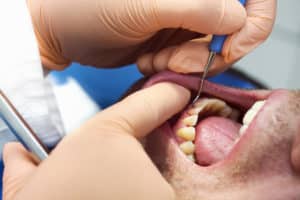Treating Your Gum Disease


There is a silent disease that over 64.7 million American adults have and it’s called gum disease. This is a condition where plaque sitting along the gum line starts to irritate the gums to the point where they recede and the teeth fall out. If you find that you have gum disease, there are still treatments that can help you reclaim your oral health and save your smile. Find out what planing and root scaling is and how it helps treat gum disease!
Gum Disease: What Is It?
Tooth decay and gum disease top the list of chronic diseases according to the National Institutes of Health. Studies show that at least 64.7 million Americans have gum disease, and that’s only including American adults! Tooth decay is a disease that affects the teeth. It happens when sugars in foods and drinks mix with mouth bacteria to create plaque. That plaque is super sticky and acidic, and when it sticks to the teeth, it decays them. Plaque collects around the gum line, causing changes to the gums as well.
Because plaque is acidic, it irritates the soft gum tissues you have. At first, your gums start to get irritated, and that irritation causes inflammation and swelling. They will be more sensitive and will bleed easier when you brush and floss. Those symptoms will only get worse over time, until the gums start to recede in an effort to get away from acidic plaque. With moderate gum disease, gum recession has started.
With severe gum disease, you will have all these symptoms, except the teeth will actually start to fall out. This is because gums have receded so far that there is not enough gum tissue to hold the teeth in place. Gums become too mushy to even hold dental implants, dentures and other dental appliances, so patients are left toothless. Gum disease encompasses the beginning stages of irritation to the ending stages of toothlessness.

How Does It Start?
Although gum disease can’t be reversed in it’s severe stages, the first stage is one that is fairly easy to combat. This beginning stage is called “gingivitis” and it is when your gums are first starting to be inflamed. A large portion of Americans have gingivitis and they don’t realize it. Coincidentally, they may also have cavities, as both of these conditions are caused by plaque. When plaque sits along the gumline, it’s acidic nature will start to irritate the gums, as we’ve mentioned.
When it’s there for too long, that is the point at which, the gums will become irritated and will start to swell up a tiny bit. If you haven’t been brushing as well as you used to, you can lift up your lips and take a look at your gums. Are they more red than they used to be? Do they bleed easier? These are all signs of gum irritation, or gingivitis. It’s a dentist’s first sign that maybe a patient is falling behind a bit on their brushing and flossing. Luckily, at this stage of gum disease, you can stop that inflammation, irritation and bleeding if you invest a bit more time in more meticulous brushing and flossing.
Tips for Care at Home
You’ve noticed that your gums are starting to bleed or that they are more red than usual. Now what? It’s time to have better oral hygiene to get your gums back to the lighter pink color they should be. You can get better gum health and combat the early stages of gum disease by:
- Brushing your teeth more often. The American Dental Association recommends that all patients brush at least twice a day, for two minutes at a time. If you have gingivitis, try brushing 3 times a day, and especially remember to brush before you go to sleep, as you don’t want plaque irritating your gums all night. Remember, children can get gingivitis and gum disease too, so make sure everyone in your family is brushing.
- Floss every single day. Many people skip this oral hygiene routine, when it is incredibly important. Plaque irritates your gums because it is along the gum line and in between the teeth. If you don’t floss, it accelerates gingivitis and gum disease. Floss every day, making sure to get up in the gum line and scrape the teeth with the floss as you go.
- Use mouthwash. This will help kill bacteria that will turn into plaque and will keep your mouth acids at bay.
- Avoid tobacco products (especially cigarettes and chewing tobacco) as well as alcohol. Alcohol is very acidic and both of these types of products kill nerves and slowly wear away tissues, like your gums.
- See a dentist regularly. All patients (even children) should visit the dentist at least twice a year for comprehensive exams and dental cleanings. These cleanings can check how large your gum pockets are, if you have gum disease and how you can help reverse it.
- Use gingivitis detection tablets. You can get these at the store or through your dentist. The chewable tablets help you see what areas of your mouth you need to be caring for more.

Planing and Root Scaling In-Office
In our office, we do a deep gum cleaning for our patients with gum disease. This is planing and root scaling. Essentially, we use our normal scraping tool for cleanings or an ultrasonic device to clean your gum pockets. We get tartar (mineralized plaque) off your exposed tooth roots and we use our tools just under your gum surface to scrape away plaque, infection and food particles. These extra deep cleanings can help soothe inflamed gums to reverse gum disease as much as possible. To know more about this treatment and others for gum disease in-office, call Dr. Ania’s office today at 303-443-0998!


